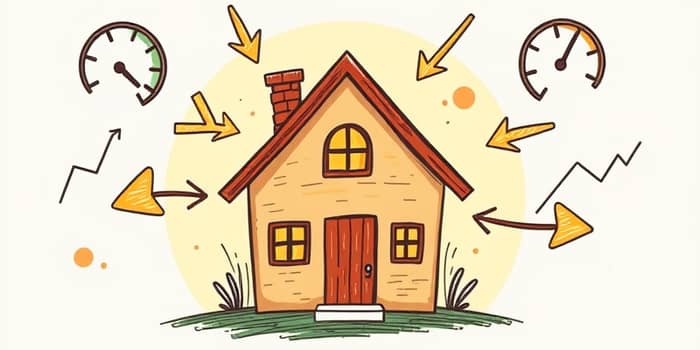Adjustable-rate mortgages, often called ARMs or variable-rate loans, combine an initial fixed interest rate with later periodic adjustments tied to market benchmarks. This makes them variable interest rate home loan products tailored to borrowers who prioritize lower early payments and flexibility. Understanding an ARM’s structure, caps, indexes and risks can help you decide if this financial instrument aligns with your long-term goals and helps you achieve homeownership under changing market conditions.
Definition and Basics
An adjustable-rate mortgage is a type of home loan in which the interest rate can change after an initial period. Also known as a floating-rate mortgage in the U.S. or a tracker mortgage in the U.K., an ARM starts with a fixed “teaser” rate for a set number of years. After this period, the rate resets based on a financial index plus a margin set by the lender. These resets often occur annually or semi-annually, aligning your monthly payments with market movements.
Unlike a fixed-rate mortgage, which locks in the same rate for the life of the loan, an ARM offers an lower initial monthly payments schedule. However, borrowers must anticipate potential rate increases over time and plan accordingly to avoid surprises when adjustment periods arrive.
Structure of an ARM
ARMs are typically described using two numbers separated by a slash, such as 5/6 or 7/6. The first number indicates the fixed-rate period in years, while the second number shows how often the rate adjusts afterward. For example:
- 5/6 ARM: Fixed rate for 5 years, then adjustments every 6 months
- 7/6 ARM: Fixed rate for 7 years, then adjustments every 6 months
- 10/6 ARM: Fixed rate for 10 years, then adjustments every 6 months
During the initial fixed period, borrowers enjoy predictable payments. Once that period ends, the loan’s interest rate will adjust based on a predetermined index plus a margin set by the lender. It is essential to review the adjustment schedule and caps before committing to an ARM product to understand how often and by how much your payment may change.
How the Interest Rate Is Determined
When an ARM enters its adjustable phase, the new rate equals a chosen index plus a fixed margin. This is often formatted as:
Adjusted interest rate = Benchmark Index Rate + Loan Margin
The benchmark index may be SOFR (Secured Overnight Financing Rate), the 1-year Constant Maturity Treasury (CMT), the Cost of Funds Index (COFI) or the phased-out LIBOR. The lender then adds a margin—commonly between 2% and 3%—to arrive at the new rate. For instance, if the index stands at 3.50% and the margin is 2.25%, the adjusted rate becomes 5.75% at the next reset.
This benchmark index plus a fixed margin approach ensures transparency, tying your payment to widely published market rates. Borrowers should track the index’s performance and understand how seasonal or economic factors can drive upward or downward trends in their mortgage costs.
Payment Changes and Caps
ARM payments can both increase and decrease following each adjustment period. Lenders typically apply three types of caps to protect borrowers from extreme fluctuations:
Initial adjustment cap: Limits how much the rate can rise the first time it adjusts after the fixed period. Many ARMs cap this increase at 2% to 3%.
Subsequent adjustment cap: Restricts increases in later adjustment periods, often around 2%.
Lifetime cap: Caps the total amount the interest rate can increase above the initial rate over the life of the loan, commonly set around 5% or 6%.
These caps play a critical role in budgeting and limits how much the rate can increase over each adjustment. Without them, some borrowers could face payments can rise sharply in volatile markets, making it challenging to maintain mortgage obligations or financial stability.
Advantages and Risks
Choosing an ARM can offer immediate financial benefits but also introduces potential uncertainties. Understanding these advantages and risks will help you make an informed decision.
- significantly lower initial rates compared to fixed-rate mortgages, reducing early monthly expenses
- Ideal for borrowers planning to move or refinance before the first adjustment
- Potential for lower payments if market rates decline during the adjustable period
- Interest rates are unpredictable, making long-term budgeting more complex
- Possible payment shock if rates rise significantly after the introductory period
- Borrowers staying past the fixed period may face unexpectedly high monthly payments and financial strain
Types of ARM Indices
After the introductory period, ARMs reference a benchmark index to set the new interest rate. Several widely used indices include:
- SOFR (Secured Overnight Financing Rate)
- 1-year Constant Maturity Treasury (CMT)
- Cost of Funds Index (COFI)
- LIBOR (largely phased out but historically significant)
Who Should Consider an ARM?
An ARM suits borrowers who plan to sell or refinance before the initial fixed period ends. If you expect your income to rise steadily, you may manage potential rate increases more comfortably. Those comfortable with market fluctuations can benefit from lower initial monthly payments and take advantage of possible rate declines. However, if you intend to stay in the home long-term without refinancing, a fixed-rate mortgage might offer more predictability and peace of mind.
Comparison with Fixed-Rate Mortgage
Comparing ARMs with fixed-rate mortgages highlights key differences in interest stability, payment predictability and risk exposure. The table below summarizes these contrasts:
Frequently Asked Questions
Can I refinance my ARM if rates go up? Yes. Borrowers often refinance into a new ARM or a fixed-rate mortgage if interest rates rise beyond their comfort zone. However, refinancing costs and eligibility criteria should be evaluated.
What happens if I can’t afford the payment after an adjustment? Contact your lender immediately. Options may include loan modification, forbearance or refinancing. Understanding your ARM’s caps can help you anticipate the maximum possible payment.
How can I know when and how much my rate will change? Your lender provides an adjustment schedule and annual notices detailing upcoming changes. Monitoring the chosen index also helps predict future adjustments.
Are ARMs more common at particular times in the market cycle? Yes. ARMs gain popularity when fixed rates are high and borrowers bet on falling or stable future rates. They become less attractive in volatile or upward-trending rate environments.
Conclusion
An adjustable-rate mortgage offers a compelling blend of lower initial costs and the potential for savings if market rates decline. By understanding how ARMs work—including benchmark index plus a fixed margin, adjustment caps and payment variability—you can choose the mortgage that aligns with your financial goals and risk tolerance. Careful planning, clear budgeting and regular monitoring position you to make informed decisions, turning the complexities of an ARM into a strategic tool for achieving homeownership.
References
- https://www.investopedia.com/terms/a/arm.asp
- https://www.bankrate.com/mortgages/basics-of-adjustable-rate-mortgages/
- https://www.rocketmortgage.com/learn/adjustable-rate-mortgage
- https://www.nerdwallet.com/article/mortgages/adjustable-rate-mortgage-arm
- https://en.wikipedia.org/wiki/Adjustable-rate_mortgage
- https://www.securityplusfcu.org/learn/education/prosperity-pulse/june-2024/the-pros-and-cons-of-an-adjustable-rate-mortgage
- https://www.pennymac.com/adjustable-rate-mortgages-arms
- https://myhome.freddiemac.com/blog/homebuying/considering-adjustable-rate-mortgage-heres-what-you-should-know










